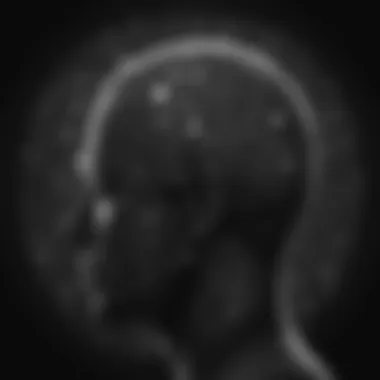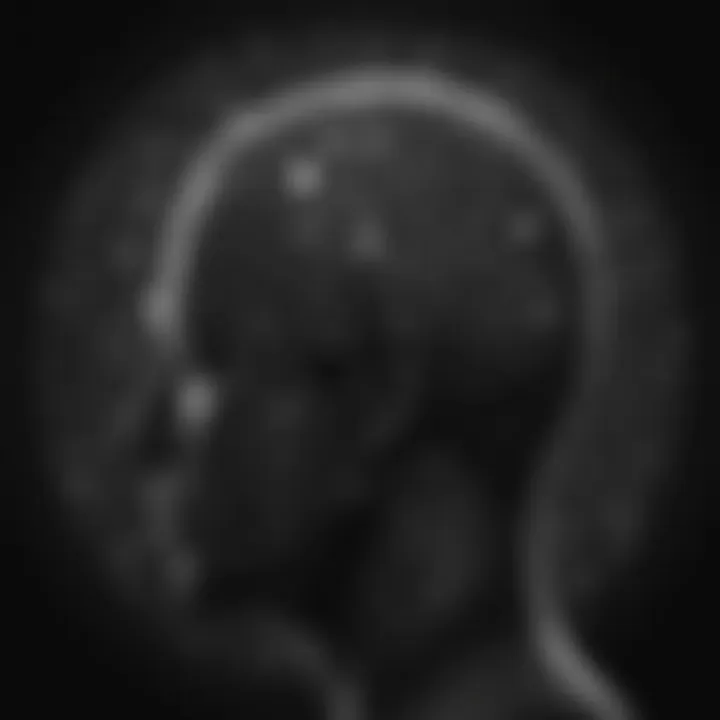Insights into the Unconscious Mind in Literature


Intro
The unconscious mind, often considered a shadowy realm of our psyche, has been a source of fascination and speculation for centuries. Literature exploring this complex topic provides a window into understanding the depths of human motivation, fears, and desires that often operate beneath the surface of conscious awareness. Countless authors and psychologists have endeavored to unravel its mysteries, and the richness of their insights continues to resonate with those who seek to enhance their understanding of human behavior and personal development. In this piece, we will explore notable works and theories that illuminate the unconscious mind, positioning readers to appreciate its profound influence on their lives.
Book Categories
Fiction and Literature
Fiction offers a compelling canvas for examining the unconscious. Authors like Franz Kafka and Virginia Woolf artfully depict the struggles between conscious thought and hidden impulses. Kafka’s The Metamorphosis dives into existential dread, showcasing how Gregor Samsa’s transformation into a monstrous insect reflects his internal turmoil. Similarly, Woolf’s Mrs. Dalloway navigates through the fragmented thoughts of its characters, illuminating how memories and suppressed emotions shape their realities.
- Key Themes:
- Alienation and existential crisis in Kafka's works.
- The fluidity of time and consciousness in Woolf's narratives.
Reading these texts not only enhances one's appreciation of artistry but also sparks reflection on the nature of thought and emotion that lives in the unspoken parts of ourselves.
Self-Help and Personal Development
Books classified under self-help delve into the practical implications of the unconscious. Titles like The Power of Your Subconscious Mind by Joseph Murphy illustrate the potential for self-improvement through understanding one’s hidden beliefs. Murphy posits that harnessing the power of the unconscious mind can lead to personal transformation.
- Key Insights:
- The impact of subconscious beliefs on our daily lives.
- Techniques for reprogramming negative thought patterns.
Incorporating these lessons can serve as a roadmap for those seeking personal growth, encouraging readers to confront and reshape their underlying beliefs for a more fulfilling life.
Book Summaries
Key Insights and Takeaways
Among the myriad of titles exploring the unconscious, several stand out for their enduring relevance:
- Sigmund Freud’s The Interpretation of Dreams: Freud originated the idea that dreams serve as a communication channel for the unconscious. His work lays out the methods to decode dreams, leading to insights about repressed desires and conflicts.
- Carl Jung’s Man and His Symbols: Jung emphasizes the role of symbols arising from the unconscious in understanding ourselves deeply. This book can guide individuals in exploring their dreams and stories, allowing for self-discovery.
- Malcolm Gladwell’s Blink: Though more contemporary, Gladwell’s work touches on intuition and gut feelings, arguing that our unconscious often guides our snap judgments more adeptly than reasoned thought.
Reading these texts provides a multifaceted view of the unconscious. Each author brings unique theories that resonate with different facets of personal experience.
How to Apply the Lessons
Applying insights from literature on the unconscious can lead to profound transformations. Consider the following approaches:
- Self-Reflection: Regularly examine dreams, thoughts, and feelings. Keeping a journal can be an effective way to identify patterns that emerge from the unconscious.
- Mindfulness Practices: Engage in mindfulness or meditation, cultivating awareness of hidden thought processes and emotional triggers.
- Therapeutic Exploration: Therapy can provide a safe space to explore unconscious beliefs and emotions, offering professional guidance to navigate through difficult revelations.
Exploring the unconscious is not just an academic endeavor; it’s a practical journey toward understanding oneself more fully.
By tapping into this reservoir of hidden thoughts and feelings, individuals can unlock deeper motivations behind their actions and foster substantial personal growth.
As we continue to unpack the literature surrounding the unconscious mind, it becomes apparent that this exploration offers not just academic knowledge, but a chance to embark on an enlightening journey toward self-discovery and empowerment.
The Foundations of the Unconscious Mind
Understanding the foundations of the unconscious mind is crucial for grasping the complexities of human behavior, thought, and creativity. This section illuminates how the unconscious shapes our emotions and actions beyond conscious awareness. Several key elements invite us to look closer at the innermost workings of the mind and their far-reaching effects in various fields, such as psychology, literature, and philosophy. By delving into its foundations, readers can appreciate the nuances of literary works that engage with the unconscious, sparking deeper conversations about identity, motivation, and reality itself.
Historical Context
To make sense of the unconscious, one must first navigate the historical terrain surrounding it. The notion of the unconscious was not always widely accepted; it has traveled a rocky road from obscure concept to a cornerstone of psychological inquiry. Early philosophies hinted at ideas of the unconscious, but it wasn't until the late 19th and early 20th centuries that it garnered substantial attention.
Sigmund Freud played a pivotal role in this transformation. His writings stirred not only the medical community but also writers, artists, and thinkers of all stripes, leading to a richer understanding of human psyche dynamics. Freud proposed that our actions are often governed by hidden desires and unresolved conflicts, laying the groundwork for future explorations of the unconscious in literature and psychology.
Psychological Theories
Freudian Theory
Freudian theory, established by Sigmund Freud, contends that the unconscious mind holds suppressed thoughts, emotions, and memories that influence behavior. Freud particularly emphasized dreams as a window into this hidden realm, with each symbol or scene representing a concealed desire or conflict. This emphasis on dreams contributes to the popularity of his work, as they are a tangible link between the conscious and unconscious experiences.
A unique feature of Freudian theory is its focus on childhood experiences, positing that these silent drivers shape one’s personality and emotional responses well into adulthood. Yet, some critics argue that Freud's approach leans heavily on a deterministic view of human behavior, which can overlook individual agency. Regardless, his concepts remain immensely influential, providing a foundation for both psychological studies and literary interpretations.
Jungian Insights
In contrast, Carl Jung introduced different angles through his insights into the collective unconscious. He proposed that this collective unconscious houses universal archetypes shared among humans, influencing our thoughts, dreams, and cultural expressions. This approach highlights a broader perspective that goes beyond personal experiences, suggesting that shared myths and symbols shape our inner lives.
Jung underscores the journey of self-discovery, or individuation, as crucial for integrating these unconscious elements into conscious awareness. His concept of archetypes is fascinating, revealing how universal narratives resonate across cultures. However, some critiques point to the ambiguity of archetypes, questioning their empirical validity. Nevertheless, Jung's exploration provides a fertile ground for literary analysis, encouraging readers to identify symbols and themes that tap into shared human experiences.
Modern Psychological Perspectives
Modern psychological perspectives have expanded previous theories with new methodologies and interdisciplinary focus. Today, insights from cognitive psychology, neuroscience, and behavioral science frame our understanding of the unconscious. Researchers now employ advanced techniques, like functional MRI scans, to observe how unconscious processes affect decision-making and perception.
An essential characteristic of modern perspectives is their emphasis on the coexistence of conscious and unconscious processes, recognizing that we often operate on autopilot—behavior influenced without active thought. This incorporates a nuanced understanding of intuition and creativity.
While modern approaches offer substantial empirical support, some argue they can overlook the emotional and existential dimensions that classical theories highlight. Yet, they decisively reshape our comprehension of the unconscious, providing tools that apply across disciplines, including creative writing, therapy, and self-reflection.
"The unconscious mind holds the key to creativity and insight, influencing our thoughts, dreams, and art in ways we may not even realize."
Thus, the foundations laid by these various theories create a complex tapestry interwoven with historical, cultural, and psychological threads. Their legacies prompt readers to ponder not just what lies beneath the surface of their own consciousness but also under that of the characters they encounter in literature.
Notable Authors and Their Contributions
When discussing the literature on the unconscious mind, it's hard to overlook the profound impact that specific authors have had on this field. Each of these notable figures not only advanced the conversation but helped to shape the understanding of the unconscious itself. Their unique perspectives and groundbreaking theories contribute heavily to both academic discussion and popular thought. Importance lies in their works, as they lay the foundation for how we understand human behavior, motivation, and the deeper layers of our minds. This section dives into key contributors, illuminating how their insights can foster a richer comprehension of the unconscious.
Sigmund Freud's Works
The Interpretation of Dreams


In "The Interpretation of Dreams," Freud lays bare the complex workings of the unconscious, providing one of the first comprehensive volumes on dream analysis. This work offers a pioneering look at how dreams serve as pathways to repressed thoughts and desires.
One significant aspect of this book is Freud's theory of dream symbolism; he suggests that the imagery in our dreams often represents hidden parts of ourselves. This characteristic has made the book a cornerstone in psychoanalysis and literary studies, sparking much debate and exploration. Freud's approach is notably beneficial for readers who seek to understand how dreams can influence waking life, as well as their overarching signals from the subconscious.
However, the idea that all dreams can be easily interpreted using a universal system has drawn criticism, making this a double-edged sword. While the insights are mind-opening, the appeal can also contest modern perspectives on the fluidity of unconscious motivation.
Beyond the Pleasure Principle
"Beyond the Pleasure Principle" takes a fascinating turn by introducing the notion of the death drive, which complicates Freud's earlier pleasure-seeking model. This work dissects human behavior as multi-faceted, emphasizing that motives can extend beyond the pursuit of pleasure. The book's intriguing concept of repeated traumatic dreams challenges prior notions of the unconscious.
Key characteristics include Freud’s in-depth exploration of trauma and repetition in dreams, illuminating how the past influences our current psyche. For those delving into the field, this work stands out as essential, pushing boundaries on what the unconscious mind encompasses.
However, its dense and somewhat cryptic prose may be daunting for some readers, which could detract from its accessibility. Nonetheless, its importance in understanding deeper layers of human motivation is undeniable.
Carl Jung's Writings
Man and His Symbols
Jung's "Man and His Symbols" marks a significant leap from Freud by weaving mythology and cross-cultural symbolism into the discussion of the unconscious. This seminal work elucidates how symbols in our dreams and artworks connect to the broader human experience. The hallmark of Jung’s writing here is the emphasis on the collective unconscious, a shared repository of human experiences.
This feature makes the book particularly powerful because it bridges personal psyche with universal themes. Readers appreciate how Jung illuminates connections among diverse cultures, making it invaluable for those wanting to grasp the communal aspects of subconscious narratives.
On the downside, Jung's profound yet abstract theories can sometimes be elusive. The challenge lies in navigating these complex ideas without getting lost in the multitude of symbols and meanings presented.
Psychological Types
"Psychological Types" further extends Jung's contributions by introducing concepts like Introversion and Extraversion, laying the groundwork for personality theory. This work splits human psyche characteristics, allowing us to grasp better how personal orientations influence unconscious motivations. It lends insight into oneself and others, enhancing interpersonal relationships significantly.
The highlighting feature here is the practical application of Jung's typology in various spheres like counseling, education, and teamwork dynamics. It provides useful frameworks for understanding person's unconscious drives based on their personality type. For readers and professionals alike, this text is a practical guide.
Nonetheless, this categorization could inadvertently pigeonhole individuals, risking over-simplification. Still, its breadth of insight into unconscious behavior remains impressive.
Contemporary Thinkers
Daniel Kahneman
Daniel Kahneman, a contemporary psychologist, redefined the exploration of the unconscious mind through his work in behavioral economics. His book "Thinking, Fast and Slow" introduces the two-tiered approach to human thought processes: the intuitive and the deliberate. The duality here illustrates how much of our decision-making often occurs below conscious awareness.
The notable trait of Kahneman's work lies in how he succinctly delineates the biases and heuristics that govern our quick, unconscious reactions. This approach beautifully complements traditional studies of the unconscious, bridging the gap between psychology and economics.
However, the statistical content may overwhelm some readers not familiar with research methods, presenting a challenge to its universal accessibility within literature on the unconscious.
Malcolm Gladwell
Malcolm Gladwell's contributions to the conversation around the unconscious are focused on social psychology and its interplay with systems of thought. His works, including "Blink," examine the role of instinctive decisions and the speed of unconscious evaluations. This book highlights how snap judgments can be surprisingly effective, while also pondering when they might lead us astray.
A key characteristic of Gladwell's work is its narrative style—engaging and accessible, which allows a broad audience to dive into vast topics with ease. The stories he weaves effectively illustrate complex ideas about how the unconscious operates. Gladwell’s accessibility encourages many to appreciate these concepts without needing specialized knowledge.
However, critiques arise regarding his oversimplification of concepts, which some researchers find problematic.
Despite this, his work facilitates essential dialogue about the efficiency and pitfalls of our unconscious reactions, blending well with the ongoing discourse in psychology and literature.
Exploring Key Books on the Unconscious Mind
The investigation of literature surrounding the unconscious mind offers a treasure trove of insights. Key books serve as portals, guiding readers through complex theories and real-life applications. By unpacking these texts, we can gain a greater understanding of how the unconscious shapes behavior, influences thoughts, and impacts our everyday choices. It’s essential to recognize that what we read plays a dual role: it both reflects and molds our perceptions. Books on the unconscious mind open up avenues for personal growth and deeper awareness, providing readers with the tools to examine their own minds.
Classic Texts
Influence of Poe's 'The Narrative of Arthur Gordon Pym'
Edgar Allan Poe’s "The Narrative of Arthur Gordon Pym" dives into the depths of human psyche mingled with adventure and horror. It showcases how fear and the unknown lurk within our subconscious. This tale captures the essence of irrational thoughts and invites readers to reflect on how their own fears may manifest. A significant contribution of this book is its exploration of human absurdity, which aligns neatly with the study of the unconscious.
Its compelling narrative not only entertains but also serves as a beneficial choice for understanding the unpredictable nature of the mind. Poe’s intricate symbolism acts as a unique feature, allowing readers to dissect layers of meaning—this can enrich one's comprehension of literature and psychology. However, Poe’s unpredictable shifts in tone may challenge some readers, requiring a keen attention to grasp the full scope of his work's insights.
The Role of Kafka's 'The Metamorphosis'
Franz Kafka's "The Metamorphosis" is another cornerstone text that intricately relates to the unconscious. The discomforting transformation of Gregor Samsa into a bug evokes profound questions about identity and alienation—what lies beneath the surface of our conscious existence? Kafka's work underscores the tension between external realities and internal struggles. This key characteristic makes it a famous choice in literary discussions centered on the unconscious mind.
The story brilliantly illustrates how societal expectations can distort self-perception, thus highlighting the importance of understanding the hidden motivations within us. A unique feature of Kafka's narrative is its surreal quality, which transports readers to a realm of inner turmoil and existential dread. While this can be enlightening, it may also present challenges for some readers who find the narrative's absurdity difficult to digest.
Modern Interpretations
The Power of Habit by Charles Duhigg
Charles Duhigg's "The Power of Habit" introduces a practical angle to the unconscious. It dives into the neuroscience behind habit formation and how these automatic behaviors arise from our subconscious. This book plays a pivotal role in elucidating how understanding these patterns can empower individuals to effect positive changes in their lives. This key characteristic of offering relatable, real-world applications makes it a valuable text in the sphere of personal development.
The unique feature of this book lies in its blend of storytelling and research; Duhigg provides compelling examples that make the science digestible. This approachable style could be a double-edged sword; while it makes complex ideas accessible, some critics might argue that it oversimplifies intricate psychological principles.
Thinking, Fast and Slow by Daniel Kahneman
Daniel Kahneman’s "Thinking, Fast and Slow" is both a guide and a challenge that tackles how we think and make decisions, exploring the dual systems of thinking: the fast instinctual decisions and the slower, more deliberative approaches. Kahneman’s work reveals how our unconscious can lead us astray, by illustrating the biases that affect our judgment every day. This key characteristic makes it an important choice for anyone seeking to understand the intersection of psychology and decision-making.
Kahneman expertly combines theory with captivating anecdotes, making intricate concepts more relatable. The book’s unique feature is its ability to illuminate the pitfalls of our thought processes, drawing on research and experiences alike. However, its dense material can be a bit taxing for some readers, and they might find it daunting to navigate through complex theories without prior knowledge.
Reading these books not only enhances our understanding but also encourages self-reflection and growth.
By exploring these significant works, readers can embark on their own journey of uncovering the layers of their unconscious mind, thereby harnessing insights that promote not just comprehension but also transformation.
The Unconscious in Different Disciplines


The topic of the unconscious mind spans a variety of fields. Each discipline approaches it with a different lens, enriching our understanding and allowing for a multifaceted exploration. Recognizing how psychology, literature, and philosophy intersect on this terrain is crucial for grasping how the unconscious influences human behavior, creativity, and existential inquiry.
Psychology
In psychology, the unconscious is often seen as a repository of thoughts, memories, and desires that lie below the surface of conscious awareness. Freudian theories, in particular, emphasize the role of the unconscious in shaping our behavior. Freud posited that unresolved conflicts and suppressed memories could influence actions and emotions, often in ways we don't consciously recognize. This perspective has encouraged methods like talk therapy, where patients explore buried feelings, seeking to bring the unconscious to light.
The beauty of psychological insights lies in their practical application. Understanding the unconscious mind allows therapists to help individuals tackle their issues. Awareness of how unconscious motives shape actions can lead to transformative personal growth. Many modern psychological approaches have retained this focus, delving into how cognitive processes operate outside our conscious awareness.
Literature
In literature, the unconscious mind spills into narratives, creating depth in characters and plots. Authors often utilize the unconscious as a source of motivation or conflict, providing readers a glimpse into the hidden thoughts that drive character actions.
Symbolism in Fiction
Symbolism is a key characteristic of fiction, enabling readers to find deeper meanings within a story. Authors use symbols to represent complex ideas and emotions that may not be immediately apparent. This technique draws on the unconscious by allowing the audience to interpret these symbols in ways connected to their own experiences.
For example, in The Great Gatsby, the green light serves as a powerful symbol of unfulfilled dreams and desires that resonate with the characters’, and ultimately society's, unconscious yearnings. This aspect makes symbolism highly beneficial for understanding the text because it invites multiple interpretations, revealing layers of meaning that reflect the complexity of the human psyche.
The unique feature of symbolism lies in its versatility. While it can evoke profound responses, it may also lead to misinterpretations if the audience does not grasp the symbol's significance, which can dilute its impact.
Poetic Exploration
Poetic exploration delves into emotions and thoughts that might be difficult to articulate. Poets tap into the unconscious to evoke feelings and reflections on existence, love, loss, and beauty. This element of poetry allows readers to resonate on a personal level; the words can evoke vivid imagery and emotions that linger.
For instance, Rainer Maria Rilke's work frequently encapsulates existential ruminations that highlight the fragmented human experience. The subconscious images portrayed invite readers to reflect deeply on their own memories and experiences relating to those themes. This ability to connect is why poetic exploration is so powerful.
However, poetic exploration may also pose challenges. The abstract nature of poetry can sometimes alienate readers who prefer straightforward narratives. Yet, those who engage with it often find new insights into their own unconscious thoughts and feelings.
Philosophy
In philosophy, the discussion of the unconscious branches into deeper existential queries. Philosophers ponder the implications of the unconscious in understanding the self and consciousness at large.
Existential Considerations
Existential considerations examine the individual’s place in the world, often involving the notion that our consciousness shapes our reality. This aligns with introspective inquiry into the unconscious, suggesting that much of what defines our identity operates out of sight.
Philosophers like Jean-Paul Sartre grappled with concepts of freedom, choice, and the burden of existence, prompting us to acknowledge the underlying influences of the unconscious. These discussions are relevant as they lead to greater self-awareness and understanding of human behavior—encouraging individuals to reflect on their motives and circumstances.
The unique feature of this perspective lies in its holistic nature, embracing emotional, psychological, and philosophical dimensions. While engaging with these ideas can be illuminating, it may also lead to uncomfortable realizations that challenge one's beliefs and assumptions.
The Nature of Consciousness
The nature of consciousness raises fundamental questions about what it means to be aware. Philosophers ask whether true consciousness can exist free from the unconscious. Discussions in this realm often explore the boundaries between conscious thought and unconscious intentions.
This exploration benefits the article by engaging with the essence of self-awareness. It prompts both philosophical and scientific discussions that bridge understanding across disciplines. The notion that our conscious mind could be merely the tip of the iceberg opens avenues for critical thought and inquiry into what drives human behavior.
However, dissecting consciousness can lead to philosophical dilemmas that may seem abstract. Balancing these concepts pragmatically can be challenging, yet they remain crucial for deepening our grasp of the unconscious's role in life.
"The unknown is not an absence, but a presence, waiting to be acknowledged and understood."
By examining the unconscious across various domains, we enrich our understanding of human behavior, creativity, and philosophical inquiry. Each discipline contributes a unique thread to the larger tapestry of knowledge about the unconscious mind.
Implications of the Unconscious Mind
The exploration of the unconscious mind has significant implications that ripple through several aspects of human thought and behavior. Understanding these implications can unlock doors to greater self-awareness, inform our understanding of artistic expression, and lend insights into therapeutic practices. Essentially, it helps to shed light on the unseen forces that shape our daily decisions and interactions. This section dives into two critical areas: how the unconscious influences behavior, and its substantial role in decision-making.
Influence on Behavior
The unconscious mind is like an iceberg; the visible part represents our conscious awareness, while a much larger section remains submerged and out of sight. This hidden portion is responsible for many of our automatic responses and behaviors that we might not recognize or understand. It can drive impulses, shape our reactions, and even dictate the formation of habits.
- Automatic Behavior: Think about habits such as nail-biting or the way someone might instinctively flinch when startled. These actions are often a direct manifestation of unconscious triggers. The mind creates shortcuts, allowing us to navigate life without constantly deliberating our responses, often based on past experiences stored away in the unconscious.
- Emotional Responses: Feelings of anger, joy, or even anxiety can be rooted in learned experiences and may surface without conscious awareness. For instance, if someone feels sudden anger when they hear a specific song, it may well be linked to an emotional memory tied to that tune, buried in their unconscious mind.
These unconscious influences highlight the complexity of human behavior. By engaging with literature that addresses these themes, readers can start to recognize patterns in their own lives, fostering greater insight and leading to potential behavioral changes.
Impact on Decision-Making
Decision-making is another crucial area significantly shaped by the unconscious. Oftentimes, people base their choices on intuition—those gut feelings that steer us away from or towards something, often without a clear rationale.
Research shows that a substantial portion of our decision-making is swayed by unconscious factors, and understanding this can lead to improved judgment. Some key points to consider include:
- Cognitive Bias: Unconscious biases can skew our thinking processes. For instance, confirmation bias can lead individuals to favor information that aligns with pre-existing beliefs while disregarding opposing viewpoints. This can influence decisions in everyday life, from social interactions to professional judgments.
- Emotional Decision-Making: The latter often overrides logical reasoning. People frequently find themselves making choices based on emotional reactions rather than thorough analysis. This emotional undercurrent often arises from unacknowledged impulses tied to unconscious urges.
In summary, the implications of the unconscious mind are vast and multifaceted. They inform behavioral patterns, revealing deeper insights into our reactions, while also shaping the way we make decisions. This interplay between the conscious and unconscious offers fertile ground for exploration in literature, psychology, and beyond.
"The unconscious mind is a treasure trove of our hidden desires and fears, schoolin' us in ways we might not even know before we act."
By delving into the literature surrounding these implications, readers can take steps towards comprehending their thought processes and behaviors, ultimately paving the way for improved personal growth.
Accessing the Unconscious
Accessing the unconscious is a subject that resonates deeply within not just psychology but literature and everyday life. Understanding this aspect helps provide a fuller picture of our inner selves, revealing layers of thoughts and feelings not easily visible in waking life. The unconscious shapes behaviors, decisions, and creative expressions, making its exploration significant for personal growth and intellectual pursuits.
Techniques and Practices
Exploring the mechanisms of accessing the unconscious mind reveals various techniques and practices that facilitate deeper understanding and integration of these hidden aspects. This section discusses three popular methods, each with its own unique characteristics, benefits, and considerations.
Dream Analysis
Dream analysis stands out as a pivotal technique to explore the unconscious. This practice, heavily rooted in Freudian psychoanalysis, emphasizes the belief that dreams are a window into our subconscious thoughts. By interpreting dreams, individuals can uncover repressed emotions, unresolved conflicts, and hidden desires.


One key characteristic of dream analysis is its focus on symbols and narratives encountered within dreams. Each element in a dream can represent more than meets the eye, making this method both fascinating and insightful.
Dream analysis is particularly beneficial due to its accessibility. Individuals can journal their dreams and work on interpretations independently or with a guide. However, there are disadvantages; interpretations can be subjective, and this leads to misreadings. Nevertheless, the advantages often outweigh the drawbacks, offering paths to healing and self-awareness.
Creative Visualization
Creative visualization is another insightful practice that encourages individuals to envision their goals or immerse themselves in imagined scenarios. This process not only stimulates creativity but also has therapeutic implications. Fostering a mental picture can bridge gaps between conscious intentions and unconscious motivations.
The key characteristic of creative visualization is its allowance for imagination to run wild within safe boundaries. It is a flexible method, adapting to numerous contexts—from stress relief to goal-setting.
A unique feature of creative visualization is its use in various therapies, making it increasingly popular in contemporary psychological practices. However, its effectiveness can vary; some may find it easy to engage, while others struggle to maintain a focused mental image. Overall, it provides a robust avenue for tapping into the unconscious.
Mindfulness Practices
Mindfulness practices, including meditation and attentive breathing, have surged in popularity as methods of accessing the unconscious. These practices promote present-moment awareness, enabling individuals to tune into thoughts and feelings that would otherwise fade into the background of daily life.
A key attribute of mindfulness practices is their emphasis on non-judgmental observation. Participants learn to observe their thoughts without immediately reacting, opening the door to self-discovery and understanding.
The unique feature of mindfulness is its adaptability; it can be practiced anywhere and often requires no specialized tools. However, achieving a significant level of mindfulness may take time and effort, which can be a barrier for some individuals. That being said, the advantages, such as reduced stress and improved emotional regulation, are compelling and often make it a worthwhile practice for accessing the unconscious.
The Role of Literature in Understanding the Unconscious
Literature serves as a bridge connecting readers with the depths of the unconscious mind. Through narratives, poetry, and character exploration, writers reveal complex emotions, desires, and fears that often lie beyond the reach of conscious thought. This written form transcends mere entertainment, inviting us to contemplate the nuances of human psychology and the underlying motives that govern behavior.
Works of literature often mirror the workings of the unconscious. Authors, in their quest to portray reality—or perhaps a version of it—tap into the realms of hidden feelings and subconscious thoughts, manifesting them through symbolic language and intricate plots. Understanding this dynamic can illuminate pathways to self-awareness and foster empathy towards others.
In examining the role of literature in understanding the unconscious, a few key elements emerge:
- Exploration of Themes: Literary works frequently delve into themes of conflict, identity, and transformation, providing insights into the human psyche.
- Emotional Resonance: Characters often embody struggles that resonate on a personal level, prompting readers to reflect on their own lives.
- Symbolism and Metaphor: These techniques allow readers to engage with subconscious ideas in a tangible way, helping to decode complex emotions and experiences.
The benefits of engaging with literature on this level are plentiful. Not only does it enhance our capacity for introspection, but it also cultivates emotional intelligence. Moreover, literature encourages dialogue about mental states, thereby normalizing discussions around mental health issues.
In this context, literature can be seen as a therapeutic medium that fosters understanding of ourselves and others, providing a unique lens to explore the intricate layers of the unconscious mind.
"Literature is a way of knowing ourselves, allowing us to explore the shadows we often avoid.”
Narrative Techniques
Narrative techniques play a fundamental role in how literature captures the essence of the unconscious mind. Through various forms of storytelling, writers convey complex psychological landscapes that reflect the characters' inner lives.
- Stream of Consciousness: This technique, aligned with the existential thought, allows readers to experience the raw, unfiltered thoughts of the characters. Writers like James Joyce and Virginia Woolf masterfully employed this, crafting narratives that flow in a way that mimics human thought processes.
- Non-linear Timelines: By disrupting chronological storytelling, authors can emphasize the fragmented nature of memory and thought. This technique invites readers to piece together narrative threads, much like one sifting through their subconscious cognition.
- Symbolic Digressions: Writers often employ symbols throughout their narratives to evoke layers of meaning, tapping into shared human experiences. These symbols can encapsulate deep emotional truths that the explicit narrative may not directly express.
Through these techniques, readers are prompted to engage more thoughtfully with the material. They spark connections between the text and personal experiences, uncovering insights about their own unconscious motivations.
Character Development
Character development is another essential aspect of literature that enables a deeper understanding of the unconscious. The evolution of characters often mirrors our attempts to confront our own hidden truths and desires, prompting reflection and self-assessment.
- Inner Conflict: The representation of internal turmoil within a character can resonate with readers as they reflect on their personal struggles. This portrayal creates a shared connection, making the exploration of the unconscious a communal experience.
- Archetypal Characters: Characters often embody archetypes, which tap into collective unconscious themes. Carl Jung emphasized this connection between individuals and archetypal figures in literature. Stories featuring hero's journeys or troubled souls can evoke profound recognition in readers.
- Transformation Arcs: When characters undergo substantial changes through their journeys, it sheds light on the power of the unconscious to influence growth and self-discovery. Observing such transformations can inspire readers to consider their own paths toward personal development.
Future Directions in Research
Research in the unconscious mind continues to evolve, revealing rich avenues for future exploration. The subject carries profound implications across multiple disciplines, such as psychology, literature, and philosophy. As academics and practitioners understand more about the unconscious, they uncover pathways that illuminate human behavior, creativity, and decision-making processes. This article aims to highlight emerging theories and interdisciplinary approaches, both of which are vital in forging a deeper comprehension of the complexities of the unconscious mind.
Emerging Theories
The landscape of theories surrounding the unconscious is expanding as researchers draw from various fields. One notable trend is the increased interest in neuroscientific perspectives. Recent advances in brain imaging technology have opened the doors to observe brain activity in real-time. This has led to more nuanced understandings of how unconscious processes influence conscious thought, decision-making, and behaviors.
A particular focus is on implicit bias and how deep-seated preferences shown in the unconscious can steer choices without conscious awareness. For instance, studies show how these biases can affect hiring practices, reinforcing the significance of unconscious influences in organizational contexts.
Moreover, the concepts of multiple selves in the psyche have gained traction. Individuals may hold contradictory beliefs, wishes, or fear deep within, which can emerge in surprising ways. Understanding these facets may yield breakthroughs in therapy, offering new techniques for change.
Here are some emerging theories and concepts:
- The connection between memory and the unconscious: Researchers are investigating how memories are stored and retrieved unconsciously, affecting present behavior.
- Insights into the cognitive unconscious: This examines how the brain processes information without conscious awareness and how it shapes perceptions and actions.
Interdisciplinary Approaches
To truly fathom the workings of the unconscious mind, an interdisciplinary approach is becoming increasingly necessary. By pulling insights from various fields, scholars can weave a richer tapestry of understanding.
For instance, integrating literature with psychology can unearth new interpretations of characters and motivations in novels. Analyzing how authors portray the unconscious can shed light on universal truths about human experience. Additionally, philosophical frameworks can provoke deeper reflection on the nature of consciousness and the self.
The cross-pollination of ideas can further enhance research methodologies. By utilizing qualitative techniques from anthropology or sociology, researchers can explore cultural impacts on the unconscious, thus widening the perspectives included in the scholarly discourse.
- Cognitive Science: This discipline can provide insights into cognitive processes tied to unconscious thought.
- Cultural Studies: Researching societal narratives can help unpack how cultural contexts shape unconscious beliefs and biases.
In summary, the future directions in the research of the unconscious mind hold immense promise. Emerging theories unveil potentialities that could nurture personal growth and deepen scholarly knowledge. Through interdisciplinary collaboration, a more comprehensive understanding awaits that may reshape existing paradigms in psychology, literature, and beyond.
End
In wrapping up our exploration, the concept of the unconscious mind emerges not just as a subject of psychological inquiry but as a pivotal theme woven throughout literature. This rich background demonstrates how classic and contemporary writings variously probe the depths of human experience, revealing the hidden forces that steer behavior and shape our realities. The benefits of understanding the unconscious are manifold; it aids in self-reflection, enhances personal growth, and enriches our interpretation of both literature and life.
When we analyze literary works through the lens of the unconscious, we unearth deeper meanings behind characters’ actions and narrative choices. This perceptiveness fosters a more profound appreciation of the art, helping us to grasp the complexities of motivation and desire portrayed by authors.
Recapitulating the Significance of the Unconscious
As we delve into this topic, it is crucial to highlight how the unconscious serves as a reservoir for our unacknowledged thoughts and emotions, notably influencing decision-making and interpersonal relationships.
The significance can be summarized through a few key points:
- Informed Insight: Literature acts as a mirror reflecting the intricacies of the unconscious. For instance, analyzing a character’s dreams in literature might reveal their suppressed fears or desires, aligning with Freudian theory.
- Psychological Tools: Understanding the unconscious can serve as a practical tool in real-world scenarios, such as therapy or self-help practices. Literature provides a narrative to discuss these often-unarticulated thoughts.
- Cultural Reflection: The exploration of the unconscious in literature also captures cultural nuances, suggesting that various societies interpret similar psychological phenomena through diverse narratives.
"To be truly understood, you must first dare to understand yourself."
— Anonymus
Thus, in revisiting the role of the unconscious within this discourse, we see that it extends beyond theory, entering the realm of personal and societal transformation. The interplay of awareness and oblivion continues to inspire exploration, artistry, and scholarship alike. By unpacking the unconscious through literary lenses, we gain better access to not only the texts but also our very selves.



